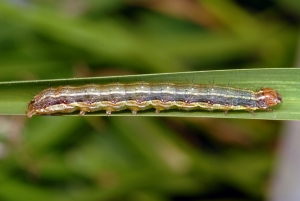Resources put growers on front foot against FAW
Resources put growers on front foot against FAW
Author: media@grdc.com.au | Date: 03 Aug 2020

Grain growers have access to a range of information and resources to help them identify and – if required – manage the incursion of fall armyworm (FAW) in Western Australia.
The Grains Research and Development Corporation (GRDC) has collated information on its website regarding FAW’s lifecycle, identification, at-risk crops, monitoring and management options relevant to grain growers.
This comes as growers in WA’s Mid West region are encouraged to be on high alert for FAW after a single adult moth was recently found in a pheromone trap at Geraldton monitored by the Department of Primary Industries and Regional Development (DPIRD).
GRDC Manager Biosecurity Jeevan Khurana said GRDC had been proactive in preparing for the potential arrival of FAW before it was first detected in Australia earlier this year, due to the reports of rapid spread in other countries.
“Through the Plant Biosecurity Research Initiative (PBRI), the GRDC has formed collaborative research partnerships with other plant-based research and development corporations (RDCs), the Department of Agriculture, Water and the Environment and Plant Health Australia, while also working closely with state departments including DPIRD to ensure an effective response,” Dr Khurana said.
“The GRDC has coordinated a co-investment partnership with the Australian Centre for International Agricultural Research (ACIAR), the Cotton Research and Development Corporation, FMC Australasia and Corteva Agriscience in a CSIRO-led project examining the genetic make-up and insecticide sensitivities of FAW, which will ultimately help growers better manage the pest.
“The GRDC has also invested in a cesar-led project investigating FAW biology, spread and establishment potential, as well as options for improving industry capability to manage the pest now and into the future.”
Dr Khurana said the GRDC had worked closely with agricultural chemical companies, other RDCs and the Australian Pesticides and Veterinary Medicines Authority via Plant Health Australia so growers could have access to chemical control options for FAW via permits.
“The GRDC applied for pre-emptive chemical permits for FAW, with the first permit issued in April 2018 and the second in February 2020,” he said.
“We are working with industry to assess all treatment options, including chemical options.
“Insecticides will remain an important part of a FAW integrated pest management program, together with biological control and good agronomic practices.
“Our focus will also be on minimising the risk of insecticide resistance development, particularly in other related pests.”
WA producers, agronomists and home owners are reminded to report suspected fall armyworm damage to DPIRD’s Pest and Disease Information Service on 08 9368 3080, padis@dpird.wa.gov.au or the MyPestGuideTM Reporter app.
The GRDC’s FAW resources can be accessed via the GRDC website.
DPIRD’s FAW media release can be accessed via the DPIRD website.
Contact details
For interviews
Dr Jeevan Khurana, Manager Biosecurity, GRDC
0428 104 946
jeevan.khurana@grdc.com.au
Contact
media@grdc.com.au – West
0427 189 827
media@grdc.com.au
GRDC Project Code: CES2004-003RTX, CSP2003-008RTX,
